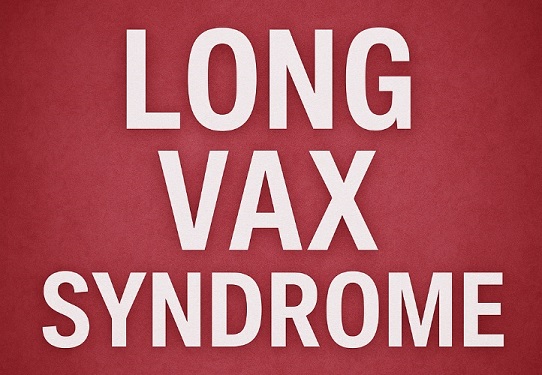Nikhil Prasad Fact checked by:Thailand Medical News Team Jul 02, 2025 6 months, 5 days, 1 hour, 53 minutes ago
Medical News: Medical Experts Propose Groundbreaking Treatment for Longvax Syndrome
In a major scientific development, researchers have unveiled a new multiphase therapeutic strategy to treat Longvax—a condition marked by chronic illness following COVID-19 vaccination. This
Medical News report draws on a study led by Dr. Jose Crespo-Barrios from the Department of Proteomics at Regeneratics, Madrid, Spain, and outlines a carefully structured treatment approach called Vaxtherapy. This protocol directly targets the persistent spike protein from the vaccines that has been implicated in a range of debilitating symptoms.
 New Protocol to Treat COVID-19 Vaccine Spike Disease or Longvax Syndrome
New Protocol to Treat COVID-19 Vaccine Spike Disease or Longvax Syndrome
The study reveals that in some individuals, fragments of the spike protein derived from the vaccine can linger in the body for months—up to 15 months in some cases—leading to a cascade of health issues. These include formation of microscopic blood clots, immune system dysfunction, and reactivation of dormant viruses. The spike protein, originally meant to train the immune system, can become a dangerous agent of persistent inflammation and multi-organ complications if not cleared effectively.
The Vaxtherapy Four-Step Treatment Plan
1. Restoring Blood Flow with Fibrinolytics
The first stage of the Vaxtherapy protocol aims to break down resistant microclots—referred to as fibrin amyloid-resistant microclots (FARMs)—that reduce blood flow and impair the immune system’s ability to access affected tissues. The use of oral fibrinolytic agents such as nattokinase, serrapeptase, and lumbrokinase is proposed. These agents are preferred over blood thinners because they target clots without significantly increasing the risk of bleeding. Without addressing these clots, other therapies may not reach the tissues where they are needed most.
2. Neutralizing Spike Proteins with Monoclonal Antibodies
After reestablishing blood flow, the second step uses a cocktail of monoclonal antibodies—such as casirivimab, imdevimab, and sotrovimab—to neutralize the lingering spike proteins. These antibodies bind specifically to the receptor-binding domain (RBD) of the spike, rendering it inactive and halting its harmful effects. This also helps to rebalance the immune system by reducing chronic immune overactivation triggered by spike presence.
3. Clearing Reactivated Pathogens
Once the spike is neutralized and tissues are accessible, the third stage targets viruses and bacteria that may have reactivated due to immune suppression. Common reactivations include Epstein-Barr virus (EBV) and varicella-zoster virus (VZV). The protocol includes antiviral medications, antibiotics, and antiparasitics where appropriate. Careful sequencing is emphasized to avoid resistance development and ensure maximum efficacy.
4. Supporting Tissue Repair and Regeneration
The final stage focuses on c
ellular regeneration and metabolic recovery. Supplements like ubiquinol, pyrroloquinoline quinone (PQQ), taurine, and resveratrol are recommended to support mitochondrial function and restore damaged tissues. In severe cases, regenerative cell-based therapies, including the use of endothelial progenitor cells (EPCs), may be necessary—though these come with additional considerations regarding safety and oversight.
How Vaxtherapy Differs from Symptom Management
Unlike conventional approaches that only alleviate symptoms, Vaxtherapy proposes a comprehensive, stepwise solution rooted in the biological mechanisms of vaccine-induced injury. The therapy is designed to reverse the actual causes of longvax—namely spike protein persistence, microvascular blockage, immune imbalance, and tissue breakdown—offering the possibility of long-term recovery.
The protocol also accounts for cases where spike protein production may continue due to residual vaccine mRNA instructions embedded in the body’s cells. In such instances, additional research is needed, but the current Vaxtherapy structure is still thought to offer benefits by reducing the downstream damage.
Evidence-Based But Awaiting Clinical Trials
While the Vaxtherapy model is based on extensive literature, case observations, and biological plausibility, it has not yet undergone large-scale randomized controlled trials. Nevertheless, each phase is supported by existing clinical data. For instance, fibrinolytics like nattokinase have demonstrated success in breaking down abnormal clots. Monoclonal antibodies like sotrovimab have shown efficacy in early COVID treatment. And antiviral therapies such as ganciclovir have been used to suppress herpesvirus reactivations.
Importantly, all four stages are designed to work in sequence—starting regeneration too early or treating infections before restoring perfusion could result in reduced effectiveness or even adverse outcomes.
Conclusion
The Vaxtherapy protocol offers a promising, scientifically sound roadmap for managing the complex condition of Longvax. By aligning treatment with the specific biological mechanisms involved—clotting, spike toxicity, latent infections, and tissue damage—it moves beyond traditional symptom management and aims for real recovery. However, more research and structured clinical trials will be essential to confirm its safety, reproducibility, and long-term effectiveness. For many suffering patients, this new approach offers renewed hope for healing.
The study findings were published in the peer-reviewed journal: Diseases.
https://www.mdpi.com/2079-9721/13/7/204
For the latest on Longvax Syndrome, keep on logging to Thailand
Medical News.
Read Also:
https://www.thailandmedical.news/news/spike-proteins-continue-to-be-produced-for-over-a-year-after-covid-19-mrna-shots-causing-persistent-inflammation
https://www.thailandmedical.news/news/sars-cov-2-spike-protein-detected-in-brain-arteries-of-43-8-percent-of-vaccinated-individuals-even-17-months-after-mrna-vaccination
https://www.thailandmedical.news/news/it-was-wrong-to-have-used-the-spike-proteins-in-the-covid-19-vaccines-as-they-can-elicit-many-kinds-of-pathogenic-autoantibodies
